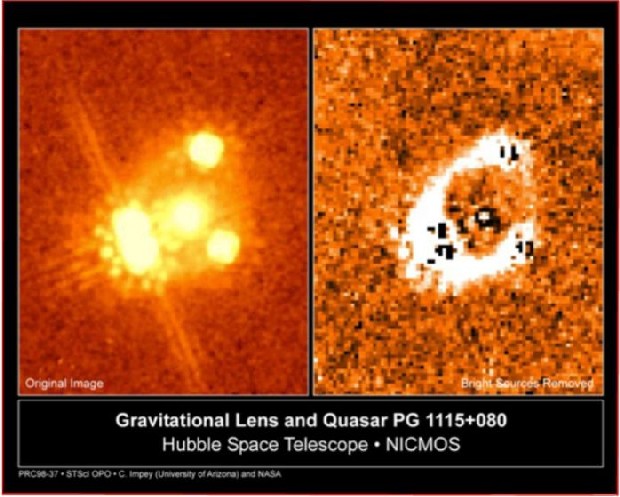
home •
about •
essential guide •
picture of the day •
thunderblogs •
news •
multimedia •
predictions •
products •
get involved •
contact
picture of the day archive subject index
Jul 25, 2006
Gravitational Lensing or Death of a Theory?The theory of gravitational lensing makes sense of images of distant quasars around nearby galaxies...until curious minds begin to doubt it.
This image from the Hubble Space Telescope shows five bright spots. Curious minds want to know: What is it? Without a theory, the image is only bright spots. So curious minds make (in the sense of the Greek root “poiein”, from which “poetry” derives) a theory.... (See the essay “What is Actually the Case”)
Analysis of the light from the four outside bright spots shows a high redshift (designated by “z”) of 1.73. The light from the inner bright spot shows a z of only 0.31. In the Big Bang theory, z is a measure of distance, so the four outside bright spots must be far away (astronomically speaking) and the inside bright spot must be nearby. The alignment is coincidental. However, such a close configuration of four objects at the farther reaches of the universe incidentally lining up around a nearby object is not likely.
Another theory supplies another possibility: In General Relativity, light passing near a massive object will be bent, much as light is bent as it passes through a lens. The effect has even been named “gravitational lensing”. If the nearby object were massive enough and a far object were aligned directly behind the nearby object along our line of sight, the gravity of the nearby object could bend the light of the far object into four virtual images flanking the nearby object.
With appropriate numbers inserted into the blank spots in the equations, the math works out, and curious minds have made (again in the sense of the Greek root “poiein”) sense of the five bright spots: One massive low-z galaxy in the foreground acts as a lens to bend light from one high-z quasar directly behind it to give the appearance of four quasars encircling the galaxy. The image even shows a faint ring of luminosity around the galaxy connecting the quasars, just as one would expect with a lens.
It’s simple. Too simple.
Further considerations raise doubts. Doubts raise further questions. Curious minds want to know: What else could it be?
Item: If the mass distribution matches the luminosity distribution in the galaxy (it’s more or less spherical and symmetric), the lens should produce a smeared-out ring, not four sharp images.
Item: When the z of the quasar is set to the reference frame of the galaxy (1.73 – 0.31 = 1.42), it falls on a “preferred value” of z. (In the Big Bang, “preferred values” of z can only mean that galaxies and quasars are distributed in shells centered on the Earth, something even more unlikely than the coincidental alignment of four quasars and a galaxy.)
Item: The faint ring of luminosity connecting the quasar images is matched by faint spokes of luminosity connecting the quasar images to the galaxy.
Item: Gravitational lensing is solely a phenomenon of mass, but galaxies are made of plasma. The primary quality of plasma is charge—electricity—and the effects of electricity overshadow the effects of mass 99 to 1. Energetic phenomena that require 96% dark matter, dark energy and black holes to power with mass require only 4% plasma—the quantity actually observed.
Halton Arp—a modern Galileo—may be heard to sigh: “There are hundreds of these things in the sky. The quasars and galaxies are connected.”
In the established institutions of astronomy, no one hears, no one sees. If galaxies and quasars are connected, z cannot be a measure of distance and the Big Bang is falsified. Textbooks will be rewritten. Grants will be lost. Careers will be undermined. Professors will be fired. The work of a century will die in vain.
But even as astronomers stop their ears and blinker their eyes, they continue to gather the evidence that testifies against their pet theory.
To be continued
Contributed by Don Scott
___________________________________________________________________________Please visit our Forum
The Electric Sky and The Electric Universe available now!

|
|

|
EXECUTIVE EDITORS:
David Talbott, Wallace Thornhill
MANAGING EDITORS:
Steve Smith, Mel Acheson
CONTRIBUTING EDITORS: Dwardu Cardona, Ev Cochrane,
C.J. Ransom, Don Scott, Rens van der Sluijs, Ian Tresman
WEBMASTER: Brian Talbott
Copyright 2006: thunderbolts.info
![]()
home •
thunderblogs •
forum •
picture of the day •
resources •
team •
updates •
contact us

